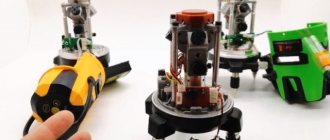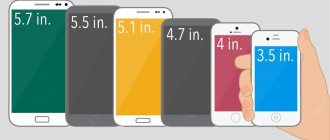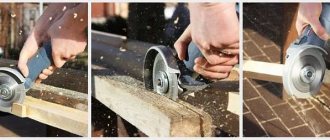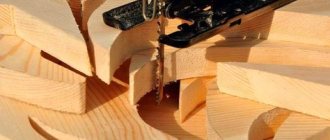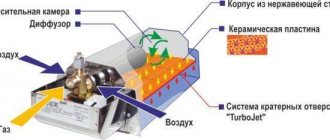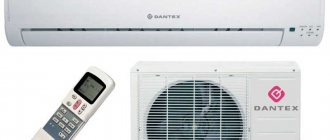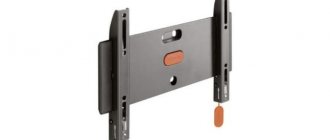For a home craftsman, who is not particularly different from the average person, a laser level and a laser level are synonymous. In fact, we are talking about devices of the same class, but with completely different functionality. When choosing between a laser level or a laser level, it is extremely important to clearly understand the goals that will be solved in the future. The following post will clearly demonstrate the actual differences between the above mentioned tools. Remember that purchasing the highest priced tool does not guarantee a perfect solution to the problem.
It is not difficult to buy a laser level in Ukraine today. In specialized stores you can always find models from various manufacturers. It is also recommended to choose a tool based on the availability of additional accessories. They are ways to significantly increase the efficiency of a tool in open space conditions (outdoors, not indoors).
Types of levels
Let's see what types of laser levels exist.
- Bubble level
The simplest type is the bubble level. It is a wooden or plastic die with built-in capsules containing a colored liquid with an air bubble. The length and width of the device may vary. Transparent capsules are made of durable glass or plastic. Such levels are widely used in household applications. There is a version with a built-in magnet for metal structures. For working with plaster, rules connected to a level are suitable.
- Professional level
The electronic type of instrument can be considered professional level. Its design is almost identical to the bubble level. A distinctive feature is the presence of a display indicating the amount of deviation from the axis and an audible signal that is triggered when 0 or 90 degrees are reached. As a rule, they are equipped with a protractor.
- Pipe level
There is a separate pipe tool for laying different pipes or round profiles. The pipe level is easy to install on a round beam due to its angular shape and the presence of magnets. There are also capsules with air, like the previous types.
- Hydraulic level
When working in one plane and over large distances, for example, laying bricks, installing the foundation of a building, leveling a floor, a hydraulic level would be a good choice. It is a transparent cabin from 5 to 25 m long. At its ends there are special containers with a scale. After filling the level with water, you should get rid of air bubbles and level the water level in the containers to the same level.
Among the professional models there are levels - laser levels. This is a more expensive, but also more accurate instrument with the lowest possible error value. Allows you to construct different planes over large distances.
How does a level differ from a level?
An electronic laser level and a level are similar devices in principle. However, they differ in characteristics, despite the fact that many users consider them identical tools. The level differs from a laser level in its increased measurement accuracy and range, although it is constructed and looks almost the same . There is a difference, for example:
- in measurement error, 0.2 mm versus 1 mm per meter of surface for a laser level;
- at a greater number of projection points, 3-5 versus 2 at the level;
- in range, from 50 meters without an amplifier versus 25 at maximum.
A laser level is needed for relatively short operations. Most models are powered by regular AA batteries. The level is equipped with powerful battery cells. It can work almost continuously. The energy-intensive process of projecting a 360-degree plane is carried out when connected to the network, while simultaneously charging the batteries.
Important! There is another difference between a level and a laser level. Due to the greater danger and range, the latter is equipped with protective equipment. The professional level comes with a remote control, which allows you to carry out the necessary measurements on a construction site by one operator.
Types of levels
Laser types of levels are also divided into different types. Their price depends on the complexity and functionality of the device.
The most inexpensive levels are discrete . They place at least two points on the plane. This tool can be called a type of laser pointer. The advantage is the long beam range - up to 400 m. However, this is not the most accurate version of the level. Also, it cannot be moved - inaccuracies immediately appear. The error compared to other levels is large.
Linear (dramatic) show entire lines, forming planes. This happens thanks to an additional lens. The markings run throughout the entire room. There is an auto-leveling system. However, the beam length is no more than 60m, and at long distances specialized glasses are required.
A rotating level is called a rotary level. He builds planes not only in straight lines, but also in inclined directions. There is a leveling system. The beam length is up to 300 m, and it is clearly visible at a maximum distance. The most expensive level option.
Accuracy and range of laser levels
The most interesting thing about laser levels is its accuracy. No matter how perfect the laser is, the further away from the light source, the thicker the beam becomes. Yes, and there is also a deviation from the vertical.
Therefore, in household models, a distance of 10 meters is usually taken, the accuracy is usually ± 0.5 mm/m. That is, at 10 meters the error can be already 5 mm.
There is no need to be afraid of such numbers - a rare room or private house will be 20 meters long, and you can check this length once with a water level. But in a bathroom or an ordinary room, no one will be able to see an error of 1-2 millimeters.
Professional rotary levels provide greater accuracy, but they are also more expensive and require very careful handling.
Advantages and disadvantages of a laser level
The distinctive qualities of the level compared to the usual level are immediately noticeable:
- High accuracy;
- Marking on all surfaces at once;
- Various planes and inclinations;
- No training required;
- Saving labor, money and marking time.
Also, do not gloss over the negative aspects:
- Higher cost;
- Functions may not be fully required for domestic use.
Thus, for domestic use it is worth considering the choice of the type of level, but for a professional the level will be an indispensable device.
Fastening methods
Laser levels are used in a variety of conditions. Depending on them, the fastening method is selected. The device can be placed on the floor or any other flat surface. In this case, settings are made according to the device location parameters.
On large construction sites, laser levels are mounted on a tripod. This method allows the device to operate stably. Even with touch, wind, or vibration, the laser will not budge.
When working with metal structures, it is recommended to use a magnetic type of laser. Its body is equipped with special magnetic plates. They allow you to securely fix the laser on a metal surface.
Device structure
The variety of models is huge, but the principle of laser levels is the same for all models.
A high power LED serves as an emitting source. As a rule, two colors are used - green or red. Such rays are brighter and more visible. The rays of such an emitter have a certain wavelength and low heat transfer. They are not afraid of mechanical damage and are economical in energy consumption. The green beam design is an innovation, it is slightly more expensive and absorbs more energy.
Various lenses and prisms provide the optical system needed to direct and shape the beam. The lens system can be either movable or fixed.
There is also a control system, which is a push-button control panel. Some models have a control panel.
Power comes from batteries or accumulator. In the latter case, the kit includes a power supply for charging.
Rating of TOP 10 best models
| Place | Name | Price |
| TOP 10 best 360 degree self-leveling laser levels | ||
| 1 | ADA instruments CUBE 2-360 Basic Edition | 10 000 ₽ |
| 2 | DEKOLL 12-HR | 7 000 ₽ |
| 3 | ADA instruments CUBE 2-360 Professional Edition | 11 000 ₽ |
| 4 | BOSCH GLL 3-80 Professional | 19 000 ₽ |
| 5 | Kraftool LL 3D | 15 000 ₽ |
| 6 | Condtrol NEO X2-360 | 9 000 ₽ |
| 7 | ELITECH LN 360/2 | 8 000 ₽ |
| 8 | ADA instruments CUBE 2-360 Green Ultimate Edition | 15 000 ₽ |
| 9 | DeWALT DCE089D1R | 31 000 ₽ |
| 10 | RGK PR-3G | 20 000 ₽ |
Level setting
The simplest actions are required with levels that have a self-regulation system. It is enough to install the level on a tripod, and the system automatically levels the horizontal. In addition, in many models the horizontal level will be maintained. If it is impossible to level it yourself, the technician will hear a signal indicating the need to install it on a more even and stable surface.
More simplified models need to be leveled by a technician after installation on a tripod. To do this, by tightening the special adjusting screws, we align the horizontal line according to the bubble capsules. After this procedure, you can begin work.
Chinese laser levels
Advanced Internet users will immediately think of ordering a laser level on the Internet in China on the same aliexpress or gearbest platform. And it is right!
A laser level can be ordered for about 800 rubles, which is very inexpensive.
A higher class laser builder can be purchased for about 2.5 - 8 thousand rubles.
Personally, I did just that 2 years ago and bought myself a Kai Tian laser builder. Then it cost about 2200 rubles. Now I don’t see such a model, but prices have become about 3.6 thousand or more rubles.
The equipment is quite rich:
- Hard carrying box;
- The level itself has legs;
- Cord and power supply for mains operation;
- Red glasses (for work - in the sun they improve the visibility of the beam).
Unfortunately, I was greedy then and did not buy a tripod and an adapter for the level. I have tripods for my camera, I was hoping it would fit, but it didn't fit the screw. And the tripod for the level has a smooth lifting handle, which is very convenient for adjusting the installation height of the level (I worked with a similar level at work).
The level arrived in about 1.5 months, everything was in order - the seller packed it well.
In principle, I am satisfied, as are all those to whom I let work with him.
Technical properties
According to the number of beams, levels can be with 1 - 2 beams - the most inexpensive and with the ability to build planes with different inclinations. The number of beams can reach up to 5. Such devices are more expensive. 1 – 2 beams will be required in all simple types of construction and repair work, when installing furniture. The more complex the type of work and the greater the number of planes, the more functional level may be required.
The beam length plays a big role. For domestic use, 20 m is enough; for professional work, more powerful levels with a beam length of 50 m are needed. In this case, the maximum beam length can be increased by using a receiver, which is sometimes included in the kit. When purchasing separately, you must take the level and receiver from the same company for better compatibility. On the body of the level, the maximum beam length without a receiver and with it is indicated through a slash.
Deviation from a straight line is called error. All levels have errors. The most accurate ones are professional levels, which are quite expensive. Inexpensive options have a larger error (3 - 4 mm/m), but this does not affect the quality of household work.
Operation from 2 - 3 AA batteries can last up to 25 hours depending on the number of rays. Battery devices require timely recharging. There are also models that operate from a rechargeable device.
The housing protects against moisture and damage. The protection class must be at least IP54, especially for outdoor work.
Parameters for choosing a level for construction/repair
If you are planning a full-scale renovation or starting construction, the following set of characteristics will be optimal for choosing a laser level:
- Two planes - vertical and horizontal with the possibility of their separate inclusion.
- Zenith, nadir and plumb.
- The scanning angle of the planes is about 120-140°; you can get a full 360° by rotating it several times.
- Self-leveling with position change alarm.
- Possibility of locking self-leveling.
- A bright beam with a range of at least 10-15 m.
You may also need a receiver, so the level must work with it.
There is no need to provide specific models and their prices - parameters are constantly improving, and prices are falling. In fact, in construction tool stores you can easily select the necessary model and not put your family on water and pasta.
Additional properties
Some features are not available on all models. Devices that provide these functions make the model more expensive. These functions include:
- Self-leveling simplifies preparation for work and controls the accuracy of markings during the operation of the level;
- Turning off automatically can save battery power. It is triggered when the device remains motionless for a certain period of time (15 – 20 minutes);
- Temperature does not play a role when working in a warm room or during the warm season. The maximum minimum for cold-resistant models is up to -10 degrees. More resistant to cold weather are produced extremely rarely.
- A tripod for installation can be purchased separately from the device. In this case, you need to pay attention to the diameter of the thread; it must match on the tripod and on the level.
- Special glasses will help you see the beam better at a great distance. There is no need to use them for household work.
How to choose
Many people decide to choose a laser level for construction and repair work. The variety of models and different types have made this device quite affordable, and the consumer can only decide which one to choose.
Range
When choosing a device, it is important to determine the measurement range - from 3 to 200 meters.
Levels with small parameters are used for markings in small rooms. Such devices are not used on large construction sites, as they need to be rearranged frequently. Devices with high accuracy will not be able to show their full potential in tiny rooms, so you should not overpay for it.
Based on this, when choosing a level, adhere to the following rules:
- For work inside small rooms (apartments), a reserve of 10 m is sufficient.
- When working in penthouses, where rooms are more than 10 meters in length, devices with a measurement range of 20-30 m will be used.
- To repair halls, levels of 40-80 meters are used. Larger areas require the use of levels with a beam range of 100 meters or more.
Alignment Features
The following types of instrument alignment are available:
- Manual.
- Auto.
For manual leveling, use a bubble level. It determines the accuracy of the location of the laser device. After alignment, the legs are fixed.
In the automatic type, the emitter is located in a special liquid, which always maintains an even horizontal position relative to ground level. Such models simplify working with them: the device is placed on the surface and the liquid itself corrects the accuracy.
Beam color
When choosing a device, pay attention to the color of the beam. There are devices on sale with green and red glow. The first option is better perceived by the eye, and the second is worse, although the red diodes shine brighter.
When working with a light surface, both types are clearly visible. If you plan to purchase a laser for painting or wallpapering, then experienced builders recommend having both types. This is due to the fact that the green beam is not visible on green wallpaper. The same thing happens with red.
When performing work in open space, it is recommended to use only the green level. It is well perceived by the eye. Red light is almost invisible in bright sunlight.
Number of rays
Different models have the ability to generate different numbers of beams. They work with one beam when it is necessary to create a straight line for shelves or sockets. Two beams are used where right angles need to be created. Four beams cover a large plane, which is convenient for leveling the floor, ceiling, and tension.
Nutrition
There are three types of power:
- Batteries - provides 10 hours of continuous operation. Suitable for home use.
- Battery - used in professional models. Periodically you will have to charge the device.
- Adapter - this type works directly from the network.
Weight
Different models and types have different weights. Not heavy, up to a kilogram can be mounted on the wall. More than 1 kg. are placed on the floor. Professional models can be mounted on a tripod.
Accordingly, the heavier the model, the stronger it is. This is directly related to the material from which the level is made.
For apartment work, a “laser” weighing up to 500 g is suitable. In large rooms, the level will already weigh under a kilogram. Models weighing 4-5 kg are used on construction sites.
Alignment lock
This small but useful feature exists in models with automatic leveling. It allows you to fix the level, preventing the device from turning off or blinking when the degree of inclination changes.
This function is useful for marking at an angle.
Operating rules
Like any other tool, a level requires following basic rules when performing work.
- You must read the instructions carefully. Different models may require different ways to adjust the level, which largely determines the quality of work.
- Initially, you need to make sure that the batteries are new (the battery is charged) and the device is ready to turn on.
- Having turned on the device, we make sure that it is in working condition by the presence of a beam or dot.
- The laser easily injures the retina of the eyes, for this reason you need to loudly notify everyone present about the start of the work.
- Obstacles in the path of the beam distort the final result. It is necessary to clear the room of such things.
- The shorter the distance to the wall, the more accurate the level readings.
- An even, firm level setting will help avoid deviations.
- After this, we level it horizontally, enter the required values according to the instructions and begin work.
If these steps are followed, the operation of the device will be as accurate and reliable as possible.
About the laser level: operating principle and main characteristics
This mechanism uses a thin and bright laser beam to take measurements. For its appearance, a special design using diodes is assembled. By the way, laser radiation was initially used only by the military. Then, after a fairly long period of time, it came to medicine, and after that it slowly penetrated into other areas of our life, finding application in industry and construction.
The body of the laser level consists of plastic. It has latex or rubber inserts that prevent liquid or dust from getting inside the precision instrument. After all, the level is by no means cheap, and at a construction site sand, cement, water, and drops of paint can get on it. Therefore, housing protection is vital for this device.
Laser levels can be used both on a construction site and in an apartment for home needs. Manufacturers produce these devices in a variety of types, so you can always choose a suitable laser level, focusing on the tasks that need to be performed with its help.
Advantages of devices of this type:
1. The measurements taken with their help are very accurate: the error per meter does not exceed a few tenths of a millimeter.
2. A perfectly visible point or line is much more convenient than the target mark that ordinary levels are equipped with. After all, you can work along this line immediately, without markings, for example, by running construction equipment along it.
3. The device takes measurements at lightning speed, there is no need to prepare it for use, just take it out of the case and that’s it.
4. Having positioned the device horizontally, you don’t have to worry about anything else: it will take the measurements itself, and very quickly.
5. You don’t need to be a specialist to work with a laser level - anyone can handle it.
6. Several workers are not required for measurements - the device is operated by one person.
In general, a laser level is nothing more than a more modern descendant of all other measuring instruments: theodolites, tape measures, levels, ordinary levels. They check any vertical and horizontal surfaces that require precision.
Video. Everything you need to know about laser levels
Tips for choosing
When choosing a device, you need to clearly think through the work plan, and in accordance with this, choose the model of the level and the equipment of the level.
In addition, you need to make sure that the case is sufficiently strong and protected from moisture. Work with this device usually takes place in an environment that is unsafe for a precision instrument; for this reason, a fall or a strong impact can disrupt the settings. Greater strength of the case will help avoid accidental inaccuracies.
Everyone chooses the manufacturer themselves. However, a more well-known brand will help avoid problems with warranty, service or counterfeiting.
A household bubble level is sufficient for most types of home renovations. The purchase of a more expensive device should be motivated by the corresponding type of work performed.
Before purchasing, you need to check the readings of the device by turning it on and setting the horizon. If the readings are correct and clear, you can make a purchase.
A simpler level is much easier to repair. For this reason, repairing such a device will be cheaper.
During construction (installation of foundations, erection of walls and other types of work), a large error can cause an accident, leading to catastrophic consequences, including death. This can occur both during construction and during operation. In order to avoid this, you should choose a level with the smallest possible error. In this case, high-precision professional models are suitable.
Which is better: laser level or level?
Both geodetic height meters and household levels fall into the category of very useful devices in repair and construction. When choosing a device, you need to take into account not only its cost, but also technical differences and features:
- The levels demonstrate maximum accuracy and are suitable for construction work where it is necessary to adhere to SNIPs.
- Levels are cheaper and are designed for single use. Leveling devices often require a partner to help take measurements and apply markings.
- The difference between the levels is that they were originally intended for use indoors. They are inconvenient to use on the ground or in spacious buildings without internal partitions.
In general, professional levels are more accurate and functional devices. When used, they can replace levels; this is their important difference. Both in construction and during medium-scale repairs, they will prove equally useful.
As for the level, it is comfortable to use it in home and country work. But it cannot serve as a replacement for a leveling device and will not allow you to apply markings on the ground without unnecessary difficulties.
For large construction projects, it is better to purchase a professional geodetic instrument.
The most popular manufacturers
When choosing a level, it is worth considering what models are offered by different manufacturers.
- DEKO Laser Level LV-01 is an inexpensive model of a linear household laser level. Can be rotated 90 degrees. Mounting with suction cups or self-tapping screws. Leveled by a master. Power comes from batteries.
- Ermak 659-022 is not the most accurate Chinese device. Suitable for most household jobs. The kit includes batteries, a case, glasses, and a tripod.
- Bosch Quigo II is a household level that requires work at a distance close to the wall. Compactness of the level, self-leveling, and cost-effectiveness are the advantages of this device.
- Condtrol MX2 is an inexpensive semi-professional model. Suitable for small construction and domestic needs. Very energy efficient. The receiver will help increase the beam length. Possibility to choose the device configuration.
- Bosch PLL 360 is a rotary level with a self-leveling function. Suitable for beginner professional craftsmen. A choice of configurations is possible. Beam length up to 20 m.
- KAPRO 888 professional model with a beam length of up to 30 m. Dust protection. Possibility to choose one of three possible lines. Battery powered. Suitable for professional finishing work.
Thus, every master, from beginner to professional, can choose a laser level that is most suitable for their type of activity. It is important to understand that expensive multifunctional appliances may remain unclaimed, for example, when carrying out renovations in a small apartment. For this reason, it is worth choosing a level according to the required functions.
Concrete mixer: types, characteristics, differences, photos
Circular saw: types, characteristics, recommendations
Manufacturers and models
A good laser level is not only about suitable characteristics and a set of functions. The quality of workmanship is also important, and this depends on the manufacturer. So, along with the characteristics, you will also have to choose a brand. If you have a power tool from a certain company and are satisfied with it, you can also look for a level from the same company. If not, you will have to trust the general opinion.
It is believed that Bosh has good laser levels (line and plane builders). They have household class devices (in a green case), there are professional ones (in a blue case), in each class there are several dozen models with different capabilities and price.
Makita gets consistently good reviews. There are also a considerable number of models, the quality is stable. INSTRUMAX and ADA, which also have many successful models of different types, operate in approximately the same price category. More budget brands include Skill, Robotoolz, Zubr, and RGK.
Selecting a level for outdoor work and complex technical manipulations
The most difficult thing to make the right choice is for those who do not know how to choose a laser level for professional use. In this case, the device will be used constantly, and it will be necessary to solve complex technological problems under difficult operating conditions with its help.
When choosing mechanisms for carrying out work in open areas, you should first of all take into account such a factor as the temperature range at which the unit will be operated. Most often, laser levels and builders are used at temperatures from 5 to 40 ° C, which are also suitable for use in heated rooms. If work is planned to be carried out in the cold season, then the operating range of the device should be from -10 to 40°C. Among the devices that meet these parameters, we should mention KaiTian 5 Lines 6 Points, ADA 2D BasicLevel and KAPRO 888.
We advise you to study - Types of roofing materials for roofs
Particularly noteworthy is the ADA 2D BasicLevel builder, equipped with 3 rotating heads, which allows you to create a three-line layout. Additional advantages of the model include good line visibility even at long distances and high construction accuracy. As a result, this unit in any rating is higher than not only budget, but also professional expensive models. Its packaging is also good, including a mount and a magnetic target.
Laser model builder ADA 2D BasicLevel Chinese
Video:
In open areas, it is recommended to use equipment with a high electrical protection class (not lower than IP54), for example, the choice may fall on the KACKAD 2K-IP or ADA 6D Maxliner models. In this case, the equipment will be reliably protected from moisture and dust particles.
Builder KaiTian 5 Lines 6 Points
Laser levels that will be used in open spaces must have a tripod for mounting. If for work in closed buildings you can get by with a device that allows you to mount the unit on the wall or with a small tripod, then for more serious work it is recommended to purchase more serious auxiliary equipment of the same model so that it fits the diameter of the thread.
One of the features of high-tech laser levels is the ability to create laser planes in 2D and 4D formats, as well as project plumb points.
The cost of devices in this category starts from $110. Its good budget representative, included in almost every top laser level, is Condtrol INFINITER CL5, which allows you to quickly and efficiently carry out design work in areas with complex terrain and in buildings with an abundance of structural solutions.
The Bosch PLL 360 laser level is no less effective. The cost of the unit starts from $130, but the level has an excellent set of functions, including the ability to draw not only straight and cross lines, but also circular lines.
So, a high-quality laser level is an indispensable assistant for everyone involved in construction and repair work. A high-quality device allows you to save worker time and perform the most accurate marking, regardless of the complexity and location of the object. Most ratings suggest giving preference to devices in the mid-price category, characterized by excellent functionality and ease of use.
Although the models presented in this review belong to different segments, you can choose the most successful solutions from them based on the ratio of quality and price, as well as the scope of use. The top included an inexpensive laser combined builder made in China, KaiTian 5 Lines 6 Points, costing $50. And in terms of professional level, the ADA TopLiner 3×360 level costs $350. These models were in greater demand. Development in this direction is ongoing and new models are appearing.
Comparative video review of laser levels and builders
Video:
https://youtube.com/watch?v=Zwcj4mYwnPo
Video:
Video:
Point, linear or rotary?
All laser levels, depending on their design, are divided into four groups:
- point. This group includes the simplest equipment, and based on the name it is already clear - it is only capable of constructing points. The simplest ones are one, but there can be two or three. Models of levels of this type are used to solve simple problems: markings for fastenings for shelves, pictures, and can also be used when covering walls with wallpaper;
- linear. Such devices are projected onto the surface of the line. If there are two of them, then they form a crosshair. But there may be more such lines and, of course, with their number the functionality and cost of the device increases. They are often called plane builders, because... with their help, markings can be applied directly to the floor, walls and ceiling, thereby forming a single workspace. This is very convenient when several people are working on site at once. This segment contains professional-grade levels that can be used at almost all stages of construction or renovation. For most people, their benefits become obvious when tiling or drywalling;
- rotary. If linear type devices can project beams only at an angle of 180°, then rotary devices can form markings at 360°. By installing such a device indoors or on a construction site, you can cover a larger area than using linear builders. These functional levels are expensive and are mainly used by professionals.
- combined. It is often necessary to combine the functions of several types of laser levels at once - this is how rotary levels appear with the ability to construct additional lines and points. It is not surprising that these are the most expensive devices.
This is interesting: Electricity in your pocket or how to get energy from water and air: we explain in detail

